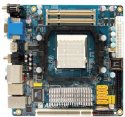“First” AM2 mini-ITX mobo targets 64-bit apps
Feb 27, 2007 — by LinuxDevices Staff — from the LinuxDevices Archive — 3 views Taiwanese boardmaker Albatron has unveiled what it claims to be the first mini-ITX motherboard built around AMD's new AM2 processor socket. Mated with a low-power, small-form-factor AMD processor, the “KI690-AM2” could suit a variety of space-constrained embedded and consumer-device applications where 64-bit processing… might work well.
Taiwanese boardmaker Albatron has unveiled what it claims to be the first mini-ITX motherboard built around AMD's new AM2 processor socket. Mated with a low-power, small-form-factor AMD processor, the “KI690-AM2” could suit a variety of space-constrained embedded and consumer-device applications where 64-bit processing… might work well.
(Click for larger view of Albatron KI690-AM2)
digg this story |
Applications cited by Albatron include car PCs, industrial PCs, POS (point-of-sales/service) systems, DIY (do-it-yourself) systems, and HTPCs (home theater PCs). Music recording and mobile video editing applications — perhaps based on the 64Studio Linux distribution — also come to mind.
AM2 appeared last year as AMD's top desktop and server socket, used for Sempron, Athlon 64, Athlon 64 X2, and Athlon 64 FX processors. Albatron does not specify which AM2 processors the KI690-AM2 will support, although AMD's 35-Watt low-power, small-form-factor Sempron and Athlon 64 parts seem like likely candidates, at least for designs without elaborate cooling systems.
AM2's primary advantage over socket 754 and other earlier AMD sockets is a claimed doubling of memory bandwidth, thanks to support for dual-channel DDR II memory. Wide memory bandwidth is especially important for AMD, because its processors have integrated memory controllers, whereas other x86-compatible chipsets relegate the memory controller to the northbridge. An on-chip memory controller reduces CPU-to-memory access times, Albatron notes, while AMD has in the past claimed its integrated memory controller approach works especially well with multi-core architectures.
The KI690-AM2 incorporates dual SODIMM slots supporting up to 2GB of memory, according to Albatron, although whether that applies to both sockets in total, or to each individually, is not clear.
The KI690-AM2 is based on an ATI RS690 chipset that includes the RS690 northbridge and SB600 southbridge. The RS690's integrated graphics capabilities are described as “Radeon X700-class” by several websites, and should suffice for Windows Vista, according to Albatron — although perhaps only for Vista Basic, which lacks the 3D-intensive graphics of full Vista versions.
The KI690-AM2 includes a wealth of interfaces sure to appeal to multimedia and home theater system builders, including onboard VGA, DVI, and HDMI graphics/multimedia connectors. If that's not enough, the board also offers HDTV composite connectors, 8-channel audio (“7.1 HD Audio Effects”), and S/PDIF (Sony/Philips digital interface) digital audio out.

Albatron KI690-AM2 ports
The KI690-AM2 appears to have a PCI card slot, and while the RS690 chipset is capable of hosting 16x PCIe interfaces, Albatron does not specify the slot's capacity.
A gigabit Ethernet interface offers lots of network bandwidth for network streams and file transfers. Also present are a pair of IEEE 1394 (firewire) ports. Firewire continues to set the standard for all kinds of video and audio editing applications, because compared to USB 2.0, it tends to offer greater data rate consistency and overall higher throughputs. The board also includes 8 USB 2.0 ports.
The KI690-AM2 comes with four SATA II connectors, and supports RAID 0 (striping), 1 (mirroring) & 0+1 (striping and mirroring). Disk performance up to 3Gbit/s is claimed. The board also offers an IDE connector for legacy ATA hard disks and optical drives.
Availability
Albatron did not respond to requests for availability details by publication time. Let's hope the board is more obtainable than AMD's low-power, small-form-factor AM2 processors, such as the fabled 35-Watt Athlon 64 X2 3800+.
Albatron earlier offered a KI51PV-754 mini-ITX board based on AMD's Socket 754. It enjoys limited distribution through online retailers such as Wacow in Taiwan and Newegg in the U.S., priced at about $300.
Boding well for AMD's future in low-power, small-form-factor devices is its recent addition of a 35-Watt Athlon 64 X2 3400+ part, and a similar S1 notebook socket part to its Embedded Assurance Program for long lifecycle products, along with several single-core 64-bit and 32-bit parts.
Meanwhile, Intel is rumored to be developing a Pentium M-based SoC (system-on-chip) that could also prove interesting for very small form-factor designs.
Thanks to Christoph Derndorfer for bringing our attention to this board.
This article was originally published on LinuxDevices.com and has been donated to the open source community by QuinStreet Inc. Please visit LinuxToday.com for up-to-date news and articles about Linux and open source.